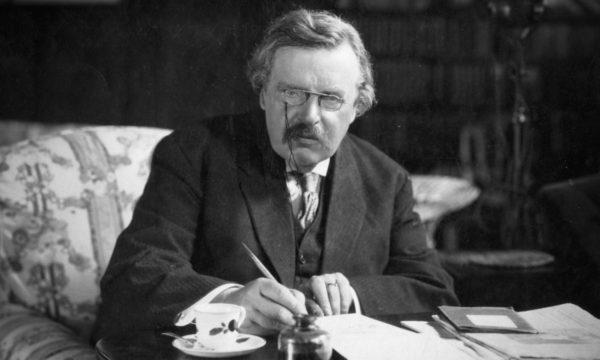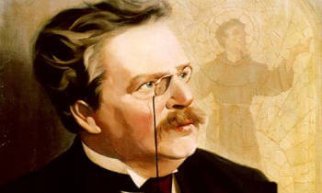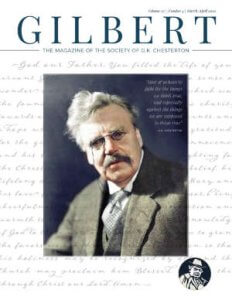Chesterton’s last novel is a reflection of his first novel. One contemporary reviewer called it “a new kind of Napoleon coming to a new kind of Notting Hill.”
Michael Herne is a librarian at Seawood Abbey, an estate owned by Lord Seawood. When Lord Seawood’s daughter and some of her friends want to put on a play called “Blondel the Troubadour,” the librarian is asked to play the part of a medieval king. Herne not only takes his role seriously by thoroughly researching the Middle Ages, when the play is concluded, he refuses to take off the costume. He remains in character, much to the befuddlement and consternation of the other players. With this device, Chesterton achieves a wonderful effect in contrast to the typical snide modern commentary on the past: he creates an opportunity for the past to offer a commentary on the present. Herne looks at his old clothes, that is, the modern clothes he once wore, with embarrassment. The modern world is embarrassing. It takes a previous age to see that.
Although Herne is the title character of the novel, he is not the main character, just as Don Quixote is not the main character in Cervantes’ great tale of the knight errant. He represents the ideal, but he is more a symbol than an actual embodiment of the ideal. He is not quite human. The human character is Sancho Panza, who believes in the ideal, defends the ideal, but lives in the real world. It is Sancho Panza’s story. In Chesterton’s novel, this role is played by Douglas Murrel.
Murrel accomplishes his feats without self-advertisement. He is great without knowing that he is great. He is even humble without knowing that he is humble. He simply knows what is right to do and he does it. Most importantly, perhaps, he is not a specialist. He is a generalist. As Chesterton describes him, “He was a man of wide culture, and had failed in all subjects.” Like me, in college.
But it is Murrel who has the great victories in the book. He puts the socialist Dennis Braintree in his place. Braintree can discuss art and literature with the aristocrats in the drawing room and then suddenly make them all uncomfortable by pointing out what snobs they are and how little they care about the working class. But when Murrel takes Braintree out for a pub crawl to meet the common people he has been defending, Braintree is surprised to find that he can’t stand to be around them, and can’t even hold a conversation with them. Whereas Murrel seems to be able to get along with anybody. True chivalry.
Murrel also rescues an artisan who insists on making paint tints using traditional methods. The old man is about to be committed to an insane asylum, but in a marvelous twist, Murrel manages to confuse the officials and get the psychiatrist committed instead. When the accusation of lunacy is the only evidence needed to lock up an inconvenient non-conformist, what could be funnier than watching a psychiatrist caught in his own trap, trying to prove that he is not a lunatic?
In the prophetic climax of the tale, Herne warns about the unnatural growth of the machine. “Things have grown incalculable by being calculated. You have tied men to tools so gigantic that they do not know on whom the strokes descend.” Don Quixote tilts at the mills once more. He is fighting a mechanical beast.
Although it is a novel, the whole thing has the feel of a play. It is mostly dialogue. There is not much action, not even much description. (One of Chesterton’s descriptions runs thus: “and after a good deal more fuss, which only a realistic novelist would bother to describe…”) Even the horse-drawn hansom cab seems like a stage prop that makes a crowd-pleasing appearance before being pulled off. But for Chesterton, there was no such thing as the novel form. It was still a new thing, 300 years after Cervantes, and Chesterton took full advantage of this new kind of literature, almost exploiting its formlessness so that he could throw anything he wanted into the mix: it is experimentation with a fantastical “what if?” a dash of romance and a large dose of political and social commentary.
Although critics both then and now have sniffed a Distributist plot in this book, they have still largely managed to miss the point. While they have acknowledged that the novel is full of his dazzling wit and that nobody except Chesterton could have written it, they all seem to expect something more or something different. They are puzzled that they are still hearing the same arguments. They want new ones. But Chesterton is defending the same truths he defended decades before. He is defending the same truths that were defended in the Middle Ages. Indeed, he is defending the Middle Ages.
And with fiction, it sometimes a thrill to be able to create an event that is completely unlikely in this world of ours. At the conclusion of the book, Lord Seawood’s daughter decides to return Seawood Abbey to the Catholic Church, because it was after all, as the name indicates, an abbey. Okay, so there’s a good chance this would never happen in modern England. But at the same time, the closing prophecy connected with it is as startling as it is sobering because we know it is absolutely true: “Whenever monks come back, marriages will come back.”





